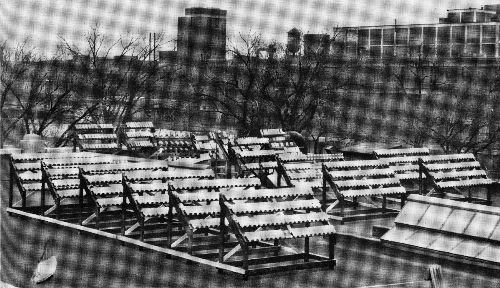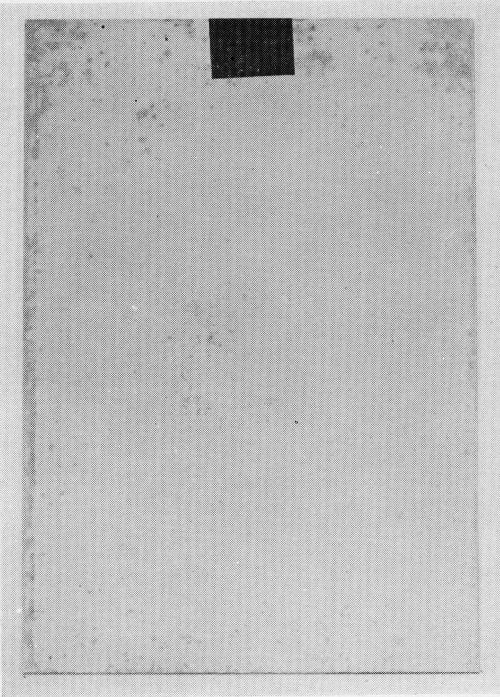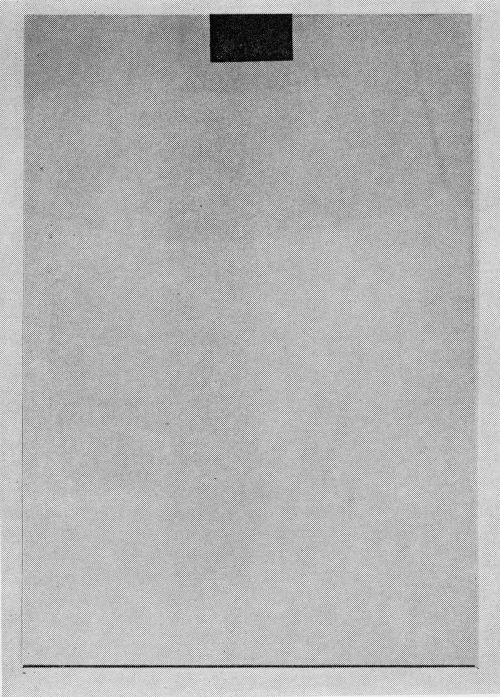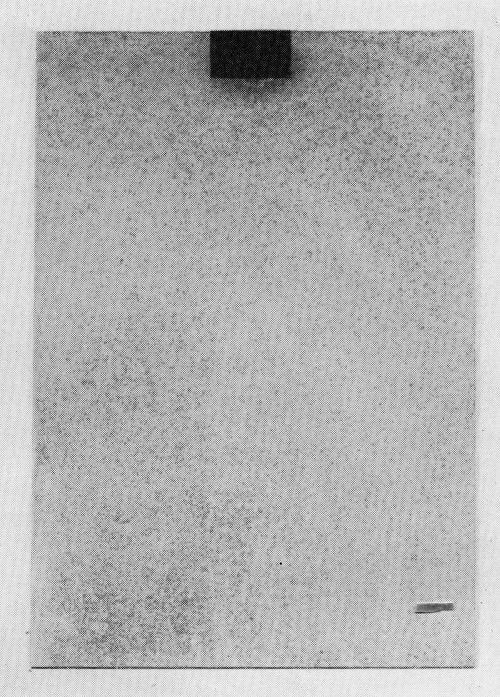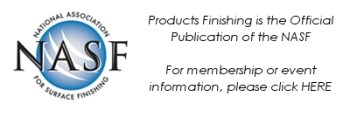The Mobile and Static Exposure of Decorative Nickel-Chromium Deposits
The corrosion resistance of nine plating systems with decoratively plated chromium was evaluated from the results of the CASS and Corrodkote tests, and Detroit Roof and Kure Beach exposure compared with the results of actual mobile service performance on cars used in Detroit.
Introduction
The past five years, more than any previous time, have produced the greatest concerted effort to improve the corrosion protection of decorative nickel and chromium deposits. The automotive industry, suppliers to the plating industry, technical societies, trade associations and independent laboratories have engaged in research programs designed for a better understanding of the mechanism of corrosion as well as improving the corrosion protection of decorative deposits. These efforts have been spurred on by several important factors. A widespread dissatisfaction with premature failure of decorative deposits was due in part to the thinner nickel deposits necessitated by the nickel shortage during the Korean war. This led to a decrease in the use of decorative plated components in the automotive industry. Secondly, the adoption of the newly developed accelerated corrosion tests, the CASS and Corrodkote, indicated that improvements in corrosion protection could be realized.
The majority of the papers published on the methods of securing improved corrosion protection from decorative deposits have relied on static corrosion sites. Roof exposure in an industrial atmosphere or exposure racks placed near the sea, or the newly developed accelerated tests have been utilized to predict actual service improvement.
The results of a preliminary mobile exposure test,1 which we conducted during the winter months of 1958-1959, indicated that the results of static exposure tests did not always agree with the results secured from actual service exposure. Accordingly, a broader mobile exposure program was planned for the winter months of 1959-1960. A mobile exposure program involves plating a considerable number of replicate parts and then securing enough cars in the same general area as exposure sites. It is far simpler, and very important, if there are points of variance, to find them, so that accelerated corrosion tests or static sites may be used to predict service improvement.
There are many important facets in the planning of a mobile exposure program which have a bearing on the value of such a program. The severity of the particular winter, that is, how much and how many times salt is spread on the streets, is an important factor in a mobile exposure program. If the winter is mild, or if the plate thickness, generally the nickel thickness, is too great, corrosion is so slight that definite conclusions cannot be drawn and the parts must be exposed for another winter. Driving habits and owner care are other variables which can influence the results of mobile exposure. Some drivers take meticulous care of their automobiles and will wash them several times a week, and usually corrosion on these cars will be extremely light. The driver whose car travels many miles a day over salted streets can expect more corrosion of decorative parts as compared to the driver who drives a few miles per day and particularly those who frequent suburban areas where streets are rarely salted.
Some of these objections are overcome if all of the plating systems under study are mounted on the same automobile. Generally, however, the number of variables under study make this impractical and necessarily a sometimes misleading "grand average" is taken. This difficulty can be overcome, in part, if a single system is arbitrarily made the control or standard and the other systems on that particular car are compared to the control. Our program made use of a single system as a control.
Procedure
One thousand un-plated steel hub caps were purchased in the buffed condition from an automotive manufacturer and were of the type used in the 1957, 1958 and 1959 model years. The use of this hub cap was fortunate in that a simple exchange of hub caps was all that was required for exposure. Secondly, the design of the hub cap (Fig. 1) made possible two thickness ranges commonly used in corrosion studies, in nickel and chromium on the same hub cap.
All hub caps were plated back to back, two caps per rack, in tanks of the same size with the same anode arrangement and the plating cycle followed commercial practice. The good correlation between individual caps of the same set at Kure Beach, Detroit roof exposure and in the accelerated tests was an indication that replicate caps were as nearly alike as is possible to prepare them.
Previous results from accelerated corrosion testing, as well as static exposure sites, had indicated that the following systems should be included in a mobile exposure program (Table 1). One hundred cars were equipped with Set A hub caps which was considered the control hub cap for each car. Twenty-five hub caps from each of the other sets were distributed at random throughout the one hundred cars. Additional hub caps from other sets, not discussed here, were also tested to make a total of four hundred hub caps on mobile exposure in and around the Detroit area.
Additional hub caps in each series were plated and exposed at Kure Beach, Detroit industrial roof atmosphere, as well as the accelerated tests, CASS and Corrodkote.
Table 1 - Plating systems included in the exposure program.
Set | Deposit on rim (Fig. 1) | Deposit in recess (Fig. 1) |
A | 1.0 mil bright nickel | 0.5 mil bright nickel |
0.01 mil chromium HT-HR* | 0.003 mil chromium HT-HR | |
B | 1.0 mil bright nickel | 0.5 mil bright nickel |
0.03 mil chromium HT-HR | 0.01 mil chromium HT-HR | |
C | 1.0 mil bright nickel | 0.5 mil bright nickel |
0.09 mil chromium HT-HR | 0.03 mil chromium HT-HR | |
D | 0.8 mil semi-bright nickel (sulfur-free) | 0.4 mil semi-bright nickel (sulfur-free) |
0.2 mil bright nickel | 0.1 mil bright nickel | |
0.01 mil chromium HT-HR | 0.003 mil chromium HT-HR | |
E | 0.4 mil cyanide copper | 0.2 mil cyanide copper |
0.6 mil bright nickel | 0.3 mil bright nickel | |
0.01 mil chromium HT-HR | 0.003 mil chromium HT-HR | |
F | 0.4 mil cyanide copper | 0.2 mil cyanide copper |
0.6 mil bright nickel | 0.3 mil bright nickel | |
0.1 mil dual chromium** | 0.034 mil dual chromium | |
G | 1.0 mil bright nickel | 0.5 mil bright nickel |
0.1 mil dual chromium | 0.034 mil dual chromium | |
H | 1.0 mil bright nickel | 0.5 mil bright nickel |
0.1 mil chromium (finely cracked)*** | 0.03 mil chromium (finely cracked | |
I | 0.3 mil bright nickel | 0.15 mil bright nickel |
0.05 mil chromium HT-HR | 0.017 mil chromium HT-HR | |
J | 0.7 mil bright nickel | 0.35 mil bright nickel |
0.03 mil chromium HT-HR | 0.01 mil chromium HT-HR | |
*High temperature - high ratio (HT-HR) chromium was deposited from a solution containing 36.0 oz/gal chromic acid, 0.225 oz/gal sulfate, 160/1 Ratio at 130°F. **Dual chromium consisted of equal thicknesses of chromium deposited from a 45 oz/gal chromic acid proprietary crack-free chromium solution, operated at 125°F and from a 28 oz/gal chromic acid proprietary solution which produces a fine crack pattern, operated at a temperature of 130°F. ***The single finely cracked chromium in Set H was deposited from a 28 oz/gal chromic acid proprietary solution, operated at a temperature of 130°F. | ||
Exposure sites
A. Corrodkote
Four hub caps from each set were given the standard 20-hour Corrodkote Test. The testing procedure conformed to ASTM Designation B380-61T.2
B. Copper-Accelerated Acetic Acid Salt Spray (CASS)
Four hub caps from each set were given the standard 16-hour CASS Test. Prior to CASS testing, the hub caps were cleaned with a slurry of magnesium oxide and all details of the test conformed with General Motors Specification GM-4476-P and ASTM Designation B368-61T.2
C. Detroit Roof Exposure
The Detroit roof used as an exposure site was the roof of our two-story East Grand Boulevard plant, (Fig. 2). It may be considered a severe exposure site with heavy industry to the northwest and railroads to the northeast. In addition, there is some air pollution from the discharge of fume hoods from the chemical laboratories located on the ground floor. It is not unusual for 1.5 mil coating of bright, dual or Watts nickel to be corroded to a low 4 or 5 rating after one winter's exposure on this roof.
During the early part of the winter of 1959-1960, in the months of November, December and early January, we experienced a number of unseasonably warm days. This type of weather results in heavy condensation in the morning and evening, producing rapid corrosion.
Four hub caps of each series were placed on exposure racks at an angle of 30° facing south in the as-plated condition on October 28, 1959, and were removed March 25, 1960. During this five-month exposure period, they were not intentionally washed or cleaned.
D. Kure Beach Exposure
Kure Beach, North Carolina is the marine exposure site of the International Nickel Company and we gratefully acknowledge the generosity and cooperation of the staff of the Kure Beach-Harbor Island testing station for exposing and rating these hub caps. Four hub caps of each series were placed on exposure racks in the eight hundred foot lot on October 29, 1959.
Because Kure Beach is an extremely corrosive exposure site and as the recessed areas of the hub cap were plated with thin deposits (0.5 mil), ratings by an ASTM method were made at the end of one, three, five, seven, nine and thirteen month intervals. The rating method corresponds to that employed by ASTM Committee B-8 in evaluating the outdoor corrosion resistance of nickel-chromium plated steel panels and is adopted from the procedure outlined in ASTM Designation D610-43. As the correlation within individual sets of hub caps was excellent, one hub cap from each series was removed and returned at the end of seven months' exposure and the remaining hub caps were removed at the end of thirteen months' exposure.
E. Mobile Exposure Site
One hundred automobiles belonging to employees of the Udylite Corporation were used as mobile exposure test cars. Each car was equipped with one control hub cap (Set A) and one of the other series to fill the remaining three wheels. None of the cars carried duplicate hub caps. The hub caps were placed on test during the period October 15 to November 1, 1959, and were removed during the period March 15 to April 1, 1960, for a total exposure time of five months which can be considered one winter. The driver of each car participating in this test was asked only to give the car his normal washing treatment and not increase the frequency of washing. He was further asked not to polish or wax the test hub caps.
The returned hub caps (88% of the hub caps were returned after exposure) were washed with a soft sponge and a mild detergent and rated in the manner described. While the winter of 1959-1960 was rather mild in the early months, it was still classified as severe by the Street Maintenance Section of the Detroit Public Works. More than 46 inches of snow fell during the winter and about 50,000 tons of salt were used to clear the streets. Salt was used about thirty-two times and, in addition, the salt trucks were operating much later in the season than usual.
Rating method
Rating of plated decorative deposits, exposed to corrosive conditions, can be a complicated and rather controversial matter. It is not at all uncommon to have a greater variation within a given set of panels, rated by three different groups of experienced "raters," than between the sets of panels under consideration. As a rating number is only a comparative figure, it is far better to have one individual examine and assign a rating number to the corroded panels or parts under examination. All of the ratings in the program were made by E. Romanowski.
The "weighted area" method of rating in corrosion studies was designed to eliminate a separate "appearance rating number." There remains a great deal of controversy among workers in corrosion studies as to the relative weight factors assigned to defects which detract from the overall decorative aspects of a deposit. The matter is further complicated if the parts or panels have been subjected to actual mobile exposure. Small nicks caused by gravel are difficult to separate from surface pitting. Fine scratch lines made in the process of removing road debris can be confused with micro-cracking or dulling associated with a dual chromium system.
There is a generally accepted belief that as long as the part is still considered decorative, the consumer is concerned principally with basis metal defects. For this reason only the degree of basis metal failure, which is red rust, was rated in this program.
Results
Tables 2 through 10 list the averaged ratings for each series of hub caps at the various exposure sites, for the exposure times listed, and may be segregated into categories as follows:
Effect of increasing crack-free chromium thickness
Tables 2, 3 and 4 compare the effect of an increasing crack-free chromium thickness, over the same nickel deposit, on the resistance to corrosion.
Table 2 - Set A exposure results: 1 mil bright nickel, 0.01 mil chromium.
Exposure sites | Average rating number | |
Rim | Recess | |
Corrodkote: 20 hours | 8.0 | 5.0 |
CASS: 16 hours | 8.0 | 6.5 |
Industrial roof: 5 months | 7.0 | 4.5 |
Kure Beach: 5 months | Overall rating: 7/VI | |
Mobile average: 5 months | 8.6 | 7.1 |
Mobile maximum | 10.0 | 9.9 |
Mobile minimum | 5.0 | 2.0 |
Table 3 - Set B exposure results: 1 mil bright nickel, 0.03 mil chromium.
Exposure sites | Average rating number | |
Rim | Recess | |
Corrodkote: 20 hours | 8.5 | 6.0 |
CASS: 16 hours | 8.0 | 7.0 |
Industrial roof: 5 months | 7.5 | 6.5 |
Kure Beach: 5 months | Overall rating: 7/VI | |
Mobile average: 5 months | 8.8 | 6.8 |
Mobile Control | 8.7 | 7.2 |
Mobile maximum | 10.0 | 9.9 |
Mobile minimum | 6.0 | 3.0 |
Table 4 - Set C exposure results: 1 mil bright nickel, 0.09 mil chromium.
Exposure sites | Average rating number | |
Rim | Recess | |
Corrodkote: 20 hours | 9.0 | 7.5 |
CASS: 16 hours | 8.0 | 7.0 |
Industrial roof: 5 months | 9.0 | 8.0 |
Kure Beach: 5 months | Overall rating: 7/VI | |
Mobile average: 5 months | 8.4 | 6.6 |
Mobile Control | 7.9 | 6.4 |
Mobile maximum | 10.0 | 8.7 |
Mobile minimum | 6.0 | 5.0 |
The Corrodkote test indicated there would be a slight, but definite increase in corrosion protection as the crack-free chromium thickness is increased from 0.01 mil to 0.09 mil over 1.0 mil of bright nickel. As the crack-free chromium thickness is increased from 0.003 mil to 0.03 mil over 0.5 mil of bright nickel, the improvement in protection is even more pronounced, but still falls short of what might be considered satisfactory.
The CASS test indicated that there should be little or no improvement in corrosion resistance, due to an increasing crack-free chromium thickness, on either the 0.5 mil thickness of bright nickel or the 1 mil thickness of bright nickel.
The Detroit roof results indicated a definite and significant increase in corrosion protection, due to increased crack-free chromium thickness, and particularly where the nickel is only 0.5 mil thick.
The Kure Beach results indicated no improvements in corrosion protection due to increased crack-free chromium thickness for the exposure time as reported. Longer exposure times (nine months) did indicate an improvement in corrosion resistance with an increasing thickness of crack-free chromium. However, even the thicker crack-free chromium deposits had deteriorated to the point where they could no longer be considered decorative or protective.
The mobile exposure sites confirmed our previous results,1 and results of others,3 in that no significant increase in corrosion protection could be gained by increasing the thickness of crack-free chromium. In fact, while the averages as reported do not so indicate, a mid-winter inspection did show that perforation to the basis metal occurred faster on the hub caps with the thicker crack-free chromium. This is not entirely unexpected because, while the porosity of the chromium has been markedly reduced, the unfavorable condition of a large cathode area (chromium) with a small anode area (nickel) can lead to rapid penetration to the basis metal.
The CASS tests and Kure Beach exposure site results alone correlate, in relative position, with the average mobile results in predicting no significant increase in corrosion protection due to increasing the thickness of crack-free chromium. This is contrary to the many reported resets and should be clarified. Most investigators, when comparing the effects of thicker crack-free chromium deposits on corrosion resistance, use 0.01 mil of chromium, deposited from a conventional solution, as a control. Startling increases in corrosion protection may be gained at Kure Beach by increasing the temperature and ratio of the chromium solution while the chromium thickness remains at 0.01 mil. This was made quite clear by the results of the ASTM Program,4 which at the end of seven months showed the conventional chromium coating over 1.5 mil of bright nickel receiving a 3/3 rating while a 0.01 mil coating of crack-free chromium over the same thickness of bright nickel received a 9/9 rating. Our own results at Kure Beach, comparing 1.0 mil of bright nickel, plated with a 0.01 mil of LT-LR (low temperature-low ratio) chromium versus HT-HR (high temperature-high ratio) chromium deposits at 0.01 mil, have been just as dramatic, showing a 0/0 rating at the end of three months for LT-LR coating on the nickel as compared to a 9/9 rating for the HT-HR chromium coating. The same trend was also apparent in CASS testing, but the provision of scrubbing the part with magnesium oxide, prior to testing, equalized the two types of chromium.
Unless adequate controls are used, the results obtained at Kure Beach and to a slight extent in the CASS test can be misleading when comparing deposits of thicker crack-free chromium. At Kure Beach, it is most important that the chromium plating conditions, that is temperature, ratio and chromic acid concentration be kept constant, if duplication within lots, or valid comparisons between lots, are to be expected. The Corrodkote results and those from our Detroit roof do not seem to show this difference in types of chromium, and in these exposures it appears that only the thickness of the chromium plate has a bearing on the degree of corrosion. The improvement in corrosion resistance due to the use of HT-HR chromium solutions at the Kure Beach exposure site may be due to thin films of chromium chromate. These films appear to be excellent corrosion inhibitors in neutral or (acetic acid) salt spray but are not as effective in an industrial atmosphere.
The presence, or absence, of films of other types also play a role in the corrosion resistance of nickel-chromium deposits exposed to an industrial atmosphere. For example, a bright nickel deposit with a sulfide-sulfur content of about 0.1%, compared to Watts nickel, will have a very active open circuit potential when immersed in a simulated rain water or the CASS or Corrodkote solution. When this bright nickel is chromium plated and exposed to an industrial atmosphere, rapid penetration to the basis metal can occur (Fig. 3). However, if the same bright nickel is made the cathode in dilute sulfuric acid, rinsed and then chromium plated as before, the corrosion protection is greatly improved (Fig. 4).
This effect can also be demonstrated by adding dimethyl-glyoxime to the Corrodkote slurry. The first bright nickel-chromium deposit, when treated with such a Corrodkote slurry will develop red spots, indicating nickel attack, in about 15 minutes. Several hours will elapse before any red spots will appear on the plate on which the nickel has been cathodically treated in dilute sulfuric acid before chromium plating.
Related improvements in corrosion protection also occur at Kure Beach if the bright nickel is buffed, although the improvement may be due only to cathodic cleaning, before chromium plating. The results of ASTM Program 44 shows a 1.5 mil deposit of bright nickel, buffed and chromium plated, receiving an average rating of 8.5, as compared to an average rating of 3.5 for unbuffed bright nickel chromium plated, after one year's exposure. The buffed bright nickel deposit provided more corrosion protection after three years' exposure than did an equivalent thickness of Watts nickel.
Quite an opposite effect can be produced if a cathodic treatment is performed after nickel and chromium plating in either a dilute solution of sulfuric acid or sodium cyanide. The untreated nickel and chromium deposit exposed to a severe industrial atmosphere during the winter for one month provides practically perfect protection (Fig. 5). The same bright nickel and chromium deposit that had been cathodically treated, after chromium plating, showed rapid penetration to the basis metal at the end of the same winter month (Fig. 6). This effect can also be demonstrated by adding dimethylglyoxime to the Corrodkote slurry. The nickel-chromium plate that had been cathodically treated after chromium plating will instantly show a mass of red spots, indicating rapid attack of the nickel, while the untreated nickel-chromium plate shows only a few spots after 15 minutes or so.
The use of dimethylglyoxime in the Corrodkote slurry can also be used to demonstrate an effect that is not predicted by potential measurements. The potential of Watts nickel in the Corrodkote or CASS solution is more noble than bright nickel,5 and when plated with chromium should be attacked at a slower rate. However, if a chromium plated unbuffed Watts nickel deposit is treated with the Corrodkote slurry that contains dimethylglyoxime, a mass of red spots indicating nickel attack, instantly appears even before the Corrodkote slurry dries. A bright nickel and chromium deposit treated in the same fashion will not show any red spots for about 15 minutes. Chromium plated unbuffed Watts nickel will also fail in the CASS test in less time than an equal thickness of chromium plated bright nickel.
These effects all illustrate the importance of the presence or absence of films in corrosion protection and question the advisability of predicting corrosion results on the basis of potential measurements made on nickel deposits, when we really are concerned with chromium plated nickel deposits.
Dual Nickel
Tables 2 and 5 compare an all-bright nickel coating with an equivalent coating thickness composed of 80% sulfur-free nickel and 20% bright nickel. The chromium coatings in both sets are the same.
Table 5 - Set D exposure results: 1 mil bi-nickel (80% sulfur-free - 20% bright), 0.01 mil chromium.
Exposure sites | Average rating number | |
Rim | Recess | |
Corrodkote: 20 hours | 9.7 | 9.5 |
CASS: 16 hours | 9.3 | 8.5 |
Industrial roof: 5 months | 7.5 | 4.5 |
Kure Beach: 5 months | Overall rating: 9/VIII | |
Mobile average: 5 months | 9.9 | 9.1 |
Mobile Control | 9.0 | 7.6 |
Mobile maximum | 10.0 | 10.0 |
Mobile minimum | 9.7 | 8.0 |
The Corrodkote, CASS and Kure Beach exposure tests indicated a significant increase in corrosion resistance due to dual or duplex nickel deposits. The increased corrosion resistance was especially significant where the nickel deposit was only 0.5 mil thick.
The Detroit industrial roof exposure site predicts little and, in some cases, no increase in corrosion resistance due to dual or duplex nickel coatings.
The mobile exposure results indicate a very significant increase in corrosion resistance due to dual or duplex nickel coatings. This was especially true in the recessed areas where the nickel thickness was only 0.5 mil.
The results of the mobile exposure sites confirm the indicated improvement in corrosion resistance noted in the CASS, Corrodkote tests and Kure Beach exposure site and support the observed results from these stationary sites that corrosion does preferentially occur in the bright nickel layer, thereby greatly retarding the rate of perforation to the basis metal.
Surface pitting, which is so pronounced in the CASS and Corrodkote tests and at Kure Beach exposure site, almost to the point of being unsightly, was so slight that it did not detract from the decorative aspects of the deposit in the mobile sites. The results of Detroit roof exposure which show little, and in some cases no improvement, in corrosion resistance due to dual or duplex nickel are consistent with previously reported results and agree with the results of others.6 Potential measurements5-6 have indicated that in an atmosphere containing sulfur dioxide, there should be little or no improvement in corrosion resistance from a dual nickel system. In these atmospheres the potential and polarization characteristics of sulfur-free and sulfur-containing nickel are so similar that preferential corrosion can hardly be expected to occur. The early work of Brown,7 which showed that the chromium plated bright side of a Watts nickel foil corroded in an industrial atmosphere with essentially the same degree of surface pitting and rate of penetration as a similarly chromium plated foil of bright nickel, makes it very clear that an industrial atmosphere does not differentiate in corrosion resistance between a sulfur-free nickel or a bright nickel.
It is interesting, however, and worth reporting that some sulfur-free nickel deposits, those deposited from the newer type semi-bright nickel solutions, when used in a dual or duplex nickel system, do show large improvements in corrosion resistance, as compared to an all-bright nickel deposit in an industrial atmosphere. This unexpected improvement in corrosion resistance, due to one type of sulfur-free nickel as compared to another type of sulfur-free nickel, does not seem to be explained by potential or polarization measurements. The answer undoubtedly lies in some condition arising at the sulfur-free bright nickel interface which, of course, is difficult to explore by potential or polarization measurements.
It would seem that in view of the fact that sulfur-free semi-bright nickel solutions are now easy to operate with a minimum of operational problems, that dual or duplex nickel coatings should be considered for all decorative items subjected to corrosive environments.
Copper-nickel-chromium
Tables 2 and 6 compare an all-bright nickel coating with an equivalent thickness of copper-nickel coating in which copper has been substituted for 40% of the total thickness. The chromium thickness is the same in both sets.
Table 6 - Set E exposure results: 0.4 mil cyanide copper, 0.6 mil bright nickel, 0.01 mil chromium.
Exposure sites | Average rating number | |
Rim | Recess | |
Corrodkote: 20 hours | 7.0 | 5.0 |
CASS: 16 hours | 6.0 | 5.0 |
Industrial roof: 5 months | 6.0 | 5.0 |
Kure Beach: 5 months | Overall rating: 0/0 | |
Mobile average: 5 months | 8.1 | 7.3 |
Mobile Control | 8.5 | 7.2 |
Mobile maximum | 10.0 | 10.0 |
Mobile minimum | 5.0 | 3.0 |
The CASS and Corrodkote tests and Detroit roof exposure site all indicated a slight decrease in corrosion resistance where copper had been substituted for a part of the total thickness of plate. The Kure Beach exposure site indicated rapid failure for the copper-nickel coating as compared to an equal thickness of all-bright nickel.
The mobile exposure sites did not show a significant difference in corrosion resistance between the all-bright nickel coating and the copper-nickel coating. This confirms previous results that copper, as an undercoating to nickel, is not harmful and in fact can even be beneficial for a certain period of time. However, unpublished results for a second winter's exposure on mobile test sites indicate that with the thin nickel over the copper, severe crater rusting, which is both unsightly and impossible to "clean up” will occur.
Copper-nickel-dual chromium
Tables 2 and 7 compare an all-bright nickel coating with an equivalent thickness of a coating consisting of copper and nickel. Conventional thickness of chromium was used on the all-bright nickel coating and a dual layer of chromium, resulting in a fine micro-cracked pattern, was applied to the copper-nickel coating. The resulting micro-crack pattern in the chromium plate had 825 crack lines per lineal inch. Table 6 may be utilized for a direct comparison of the effect of dual chromium at the stationary sites and an indirect comparison on the mobile sites.
The CASS and Corrodkote tests indicated only slight corrosion of the deposit which, of course, indicates a very significant increase in corrosion resistance due to dual chromium. Some dulling and staining was encountered but hardly enough to detract from the decorative aspects of the deposit. The Detroit roof and Kure Beach exposure sites indicated a substantial increase in corrosion resistance, particularly where the total plate thickness of copper, nickel and chromium was greater. Some basis metal corrosion occurred in the extreme recess where the total plate thickness, and particularly the chromium thickness, was low.
Table 7 - Set F exposure results: 0.4 mil cyanide copper, 0.6 mil bright nickel, 0.1 mil dual chromium.
Exposure sites | Average rating number | |
Rim | Recess | |
Corrodkote: 20 hours | 10.0 | 10.0 |
CASS: 16 hours | 10.0 | 9.9 |
Industrial roof: 5 months | 10.0 | 7.0 |
Kure Beach: 5 months | Overall rating: 9/VIII | |
Mobile average: 5 months | 9.7 | 8.0 |
Mobile Control | 8.7 | 6.9 |
Mobile maximum | 10.0 | 10.0 |
Mobile minimum | 9.5 | 6.0 |
The mobile exposure sites indicated a substantial increase in corrosion resistance due to the dual chromium. This was particularly true where the thickness of the chromium plate was greatest but, even in the recessed areas, a significant increase in corrosion protection was realized. There was a slight dulling on some of the hub caps returned but in no case was it considered severe enough to detract from the decorative appeal of the hub cap.
The improvement in corrosion resistance of a dual chromium system depends upon achieving a microscopic crack pattern in the chromium plate and apparently, as will be discussed later, there is help in this case from a copper layer under the nickel. The attainment of the microscopic crack pattern in the chromium plate decreases the cathodic chromium area with respect to the anodic nickel area,8 and while actually more nickel surface is subjected to corrosion, the rate of penetration is decreased. An interesting analysis of this effect, in terms of increasing the protective life of decorative coatings, has recently been discussed by Saur.9 There are two operational difficulties with this system which should be kept in mind. In order to achieve a fine micro-crack pattern, a minimum of 0.03 mil of chromium is necessary, and on some parts this would necessitate the use of conforming anodes. Secondly, there is the difficulty of consistently securing a uniformly fine crack pattern, especially on broad flat surfaces, so that the object may still be considered decorative. If the parts are small and relatively simple to plate, this system may be used to increase the corrosion resistance of decorative deposits without any of these problems.
Nickel-dual chromium
Tables 2 and 8 compare an all-bright nickel coating, with a normal thickness of chromium, to an all-bright nickel coating plated with a dual coating of chromium, which results in a fine micro-cracked pattern in the chromium plate. The resulting micro-cracked pattern in the chromium plate had 900 crack lines per lineal inch.
Table 7 may be used as a direct comparison at the stationary sites, and indirect comparison on the mobile sites of the influence of copper as an undercoating on the corrosion resistance of the dual chromium system.
The Corrodkote test indicated practically no corrosion of the nickel and more important, that copper as an undercoat in a nickel dual chromium system is not necessary to achieve practically perfect corrosion resistance. Some dulling and staining was noted, but again not enough to detract from the decorative aspects of the coating.
Table 8 - Set G exposure results: 1.0 mil bright nickel, 0.1 mil dual chromium.
Exposure sites | Average rating number | |
Rim | Recess | |
Corrodkote: 20 hours | 10.0 | 10.0 |
CASS: 16 hours | 8.0 | 7.0 |
Industrial roof: 5 months | 9.3 | 7.0 |
Kure Beach: 5 months | Overall rating: 7/VI | |
Mobile average: 5 months | 8.7 | 7.0 |
Mobile Control | 8.3 | 7.3 |
Mobile maximum | 10.0 | 10.0 |
Mobile minimum | 7.5 | 5.0 |
The CASS test and Kure Beach exposure site indicated little or no improvement in corrosion resistance due to a dual chromium coating over an all-bright nickel undercoat.
The Detroit roof exposure site indicated a substantial improvement in corrosion resistance due to the dual chromium system and further, that only a slight gain in corrosion resistance could be realized by substituting some of the nickel with copper.
The mobile test sites indicated little or no improvement in corrosion resistance on all-bright nickel coatings, due to using a dual chromium system. It appears, and confirms the statements of others,10 that if a dual chromium is to materially aid corrosion resistance, then copper must constitute a part of the total plate. The reason for this is not entirely clear. It has been said that if the chromium layer is micro-cracked, penetration to the basis metal is greatly retarded. In this case, the Corrodkote and Detroit roof results indicated the presence of a micro-cracked chromium layer and also dispelled any suggestion of gross cracking through the nickel to the basis metal.
Potential and polarization measurements10,11 show that copper is noble to bright nickel in sodium chloride solutions acidified with acetic acid, and it has been suggested10 that sacrificial corrosion of the bright nickel layer occurs before the copper layer is appreciably attacked. It would therefore be logical to expect that copper as an undercoat to nickel should be beneficial in CASS and possibly Kure Beach exposure. However (see Tables 2 and 6), copper substituted for some of the nickel thickness is definitely harmful when tested at these exposure sites.
It is known that copper, substituted in part for bright nickel, has a definite bearing on the type and degree of craze cracking of chromium at the 0.03 mil level when deposits from solutions that will produce cracked chromium. Perhaps this may be a factor allowing a more uniformly cracked chromium which would be more free of localized corrosion cells, which lead to pitting.
Whatever the answer, it does seem certain that copper is definitely required as part of a dual chromium system.
Bright nickel with single finely-cracked chromium
Tables 2 and 9 compare the results of all-bright nickel coatings, one with a conventional thickness of chromium, the other with a single thick layer of finely or micro-cracked chromium. The micro-cracked pattern in the chromium plate had 1,100 crack lines per lineal inch. Table 8 may be used as a direct comparison, at the stationary sites, and an indirect comparison on the mobile sites of the same thickness of bright nickel with the same thickness of dual chromium.
Table 9 - Set H exposure results: 1.0 mil bright nickel, 0.1 mil finely cracked chromium.
Exposure sites | Average rating number | |
Rim | Recess | |
Corrodkote: 20 hours | 10.0 | 10.0 |
CASS: 16 hours | 6.0 | 6.0 |
Industrial roof: 5 months | 9.2 | 7.5 |
Kure Beach: 5 months | Overall rating: 7/VI | |
Mobile average: 5 months | 8.3 | 7.0 |
Mobile Control | 8.7 | 7.2 |
Mobile maximum | 10.0 | 9.5 |
Mobile minimum | 5.0 | 3.0 |
There are objections to using one solution to achieve relatively thick layer (0.05 to 0.1 mil) of micro-cracked chromium. The covering power of dilute chromic acid bath is not as good as the more concentrated chromium solution normally used in the first stage of the dual chromium system and there is also a tendency to plate over or heal some of the micro-cracks thereby promoting random located corrosion cells.
The Corrodkote again indicated perfect corrosion resistance for the all-bright nickel and single layer of thick micro-cracked chromium, whereas the CASS test indicated no improvement in corrosion resistance over that obtained by the conventional thickness of chromium and not quite as good corrosion protection as that obtained by the dual layer of micro-cracked chromium.
The Detroit roof indicated a significant increase in corrosion protection obtained by using a single layer of thick micro-cracked chromium with essentially the same degree of protection given by the dual layer of micro-cracked chromium.
The Kure Beach results indicated that no advantage in corrosion protection would be gained by using a single layer of thick micro-cracked chromium over an all-bright nickel coating compared to either a conventional thickness of chromium or a dual layer of micro-cracked chromium.
The mobile results confirmed the CASS and Kure Beach results in that there was no improvement in corrosion resistance due to a single thick layer of micro-cracked chromium compared to a conventional thickness of chromium. Individual car results also indicated that the dual layer of micro-cracked chromium provides slightly better corrosion protection than the single layer of micro-cracked chromium.
Nickel-chromium-nickel-chromium
Tables 2 and 10 compare the results of all-bright nickel coatings, one with a conventional thickness of chromium, the other with a layer of chromium plated between two layers of bright nickel. Table 3 may be used as a direct comparison at the stationary sites and an indirect comparison on the mobile sites of the effect of the intermediate chromium layer, all other plating conditions being equal.
Table 10 - Set I exposure results: 0.3 mil bright nickel, 0.05 mil chromium, 0.7 mil bright nickel, 0.03 mil chromium.
Exposure sites | Average rating number | |
Rim | Recess | |
Corrodkote: 20 hours | 10.0 | 8.5 |
CASS: 16 hours | 9.7 | 9.6 |
Industrial roof: 5 months | 9.8 | 9.0 |
Kure Beach: 5 months | Overall rating: 9/VIII | |
Mobile average: 5 months | 9.9 | 9.6 |
Mobile Control | 8.8 | 7.3 |
Mobile maximum | 10.0 | 10.0 |
Mobile minimum | 9.8 | 8.5 |
The Corrodkote and CASS tests indicated a very significant increase in corrosion protection for the Ni-Cr-Ni-Cr system, with the CASS test being less severe in the recessed areas than the Corrodkote.
The Detroit roof exposure site indicated exceedingly good corrosion protection for this system, actually providing more corrosion protection than any other system under test.
The Kure Beach results indicated a substantial increase in corrosion protection due to a layer of chromium between two layers of bright nickel.
The mobile exposure site results were exceedingly good and did, in fact, provide the best corrosion protection of any system under test based on an individual car evaluation. Especially significant was the corrosion protection afforded the recessed areas where the total plate thickness was relatively low. This is most important because today's complicated designs make it very difficult to secure an adequate plate thickness in recessed areas. It has been reported12 that even a trace of chromium deposited between layers of nickel will be exceedingly beneficial in securing large improvements in corrosion protection.
Certainly, if the operational difficulties are not too great, and there does not seem to be any reason why they should be, this system of improving corrosion resistance would be outstanding.
Summary of results
- The results of the Detroit roof exposure did not correspond with mobile exposure tests in Detroit with the systems examined.
- The CASS test and Kure Beach exposure for the systems examined did give the order of relative merit corresponding to the mobile test results and, therefore, within limits, do predict the corrosion protection of these plating systems used on cars on Detroit streets. In view of the present state of knowledge, it is not too accurate to use Kure Beach exposure results (which might be called an accelerated test), or CASS testing cycles to predict the possible years of service on Detroit streets for most decorative plating systems. Unfortunately, due to the variations in severity of winters and owner care, this type of correlation can only be gained through years of actual statistical results on cars, and even this can be in error if thicknesses of plate and positions of the parts on the car are not given due consideration.
- The Corrodkote test failed to place some of the plating systems examined in the same relative order of merit as the mobile test and, therefore, this test may be used to predict serviceability on Detroit streets only for certain plating systems. Any chromium plating system that exposes relatively large areas of nickel, through the chromium, may give misleading results in the Corrodkote test. The rapid exhaustion of the copper and ferric-iron depolarizers, as was recently made clear by Petrocelli,13 slows the penetration rate through the nickel to the basis metal to the point of being misleading. These cases would include abnormally thin coatings of chromium as well as the finely-cracked or micro-cracked chromium coatings.
- No increase in corrosion protection may be gained by increasing the thickness of crack-free chromium beyond about 0.01 mil over bright nickel.
- Dual micro-cracked chromium or a single layer of thick finely-cracked chromium does not offer any increase in corrosion protection, as compared to 0.01 mil of conventional chromium, unless copper is used as an undercoat for the nickel.
- Of the three plating systems studied which did provide improved corrosion protection compared to the conventional copper-nickel-chromium or bright nickel-chromium coatings, the relative order of merit appears to be:
This order of merit is, of course, based upon the particular thickness of coatings we applied. All coatings were plated on articles having the same shape.
Each of these systems offers a substantial increase in corrosion protection and the choice of the system to use would have to be individually weighed with regard to the complexity of the part to be plated, and the equipment available. The economics of each of these systems, disregarding any major equipment modification, are relatively the same and it would appear that dual nickel does have an operational advantage from the standpoint of plating recessed articles as well as the general daily control of the process. The use of dual nickel in the chromium-nickel-chromium system may actually be the best system devised so far for maximum corrosion protection of parts having more complex shapes.
Acknowledgements
The authors acknowledge with appreciation the permission of The Udylite Research Corporation to publish this paper. We would also like to thank Dr. H. Brown for helpful suggestions.
References
- R.B. Saltonstall, et al., Plating, 47, 637 (1960).
- For the procedure for the Corrodkote Test, see D.M. Bigge, Proc. Amer. Electroplaters' Soc., 46, 149 (1959); for the procedure for the CASS Test, see also C.F. Nixon, et al., Proc. Amer. Electroplaters' Soc., 46, 159 (1959).
- W.H. Safranek, et al., New Finishes for Zinc Die Castings, Fourth Phase Report, December 1960; Fifth Phase Report, December 1961.
- Proc. ASTM, 61 (1961).
- A.H. DuRose, et al., Metal Finishing, 57 (3), 44 (1959); A.H. DuRose, Proc. Amer. Electroplaters' Soc., 47, 83 (1960); See Discussion Section, G.N. Flint, et al., Trans. Inst. Met. Finishing, 38, 3 (1961).
- H.M. Heiling, Metall., 14, 549 (1960); G.N. Flint, Trans. Inst. Met. Fin., 38, 2 (1961).
- H. Brown, et al., Plating, 45, 144 (1958).
- H. Brown, et al., Proc. Amer. Electroplaters' Soc., 40, 32 (1953); See also Reference 7.
- R.L. Saur, Plating, 48, 1310 (1961).
- W.E. Lovell, et al., Proc. Amer. Electroplaters' Soc. 47, 215 (1960).
- W.H. Safranek, Proc. Amer. Electroplaters' Soc., 48, 156 (1961); See also Reference 10; J.V. Petrocelli, et al., Plating, 49, 50 (1962).
- H. Brown, et al., Proc. Amer. Electroplaters' Soc., 46, 128 (1959); B.B. Knapp, Trans. Inst. Metal Finishing, 35, 139 (1958).
- J.V. Petrocelli, et al., Plating, 49, 50 (1962).
Related Content
Enhanced Functionality, Commercial Viability
Nano-particle additives modify coating performance to protect sensitive electronic devices.
Read MoreCoatings Plant Evolves with Market Trends
Expanding its focus from exclusively serving the RV industry, one of this company’s stand-alone coatings plant has successfully extended its services to additional markets.
Read MoreIndonesian Plater Finds Fast Success in Auto Market
This father/son team, inspired by inventor Michael Faraday, focuses on anti-corrosion methods and automated processes to help their Indonesian plating business flourish.
Read MoreHenry Ford Is Still Right When It Comes to Color
Who would have imagined that more than 100 years after his famous statement about any color as long as it’s black would still have relevance of a sort?
Read MoreRead Next
Episode 45: An Interview with Chandler Mancuso, MacDermid Envio Solutions
Chandler Mancuso, technical director with MacDermid Envio discusses updating your wastewater treatment system and implementing materials recycling solutions to increase efficiencies, control costs and reduce environmental impact.
Read MoreA ‘Clean’ Agenda Offers Unique Presentations in Chicago
The 2024 Parts Cleaning Conference, co-located with the International Manufacturing Technology Show, includes presentations by several speakers who are new to the conference and topics that have not been covered in past editions of this event.
Read MoreMasking Solutions for Medical Applications
According to Custom Fabricating and Supplies, a cleanroom is ideal for converting, die cutting, laminating, slitting, packaging and assembly of medical-grade products.
Read More

